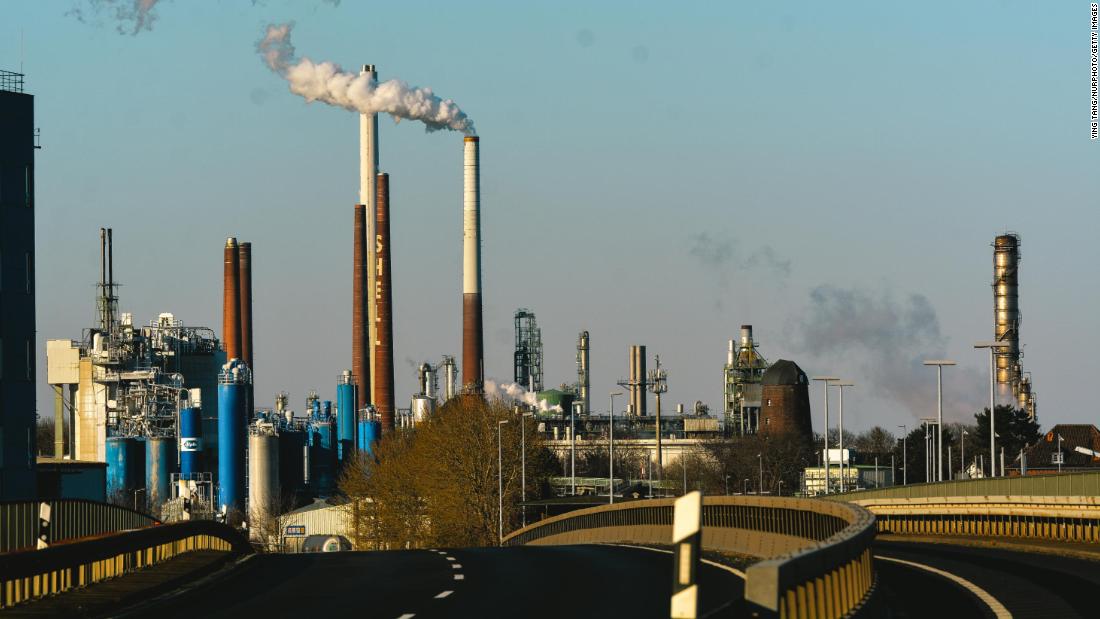Economists expect Europe’s economy to suffer as a result. Barclays analysts have slashed their eurozone growth forecast for this year by 1.7 percentage points to 2.4%. Private consumption, investment and exports are all expected to grow at a slower pace across the continent.
At the same time, the prices of energy and other commodities such as wheat and metals are rising fast. Barclays has upped its 2022 eurozone inflation forecast by 1.9 percentage points to 5.6%.
In other words, the war is stoking stagflation, which describes a period of high inflation and weak economic growth. The best recent example is the 1970s, when an energy supply shock hammered developed economies.
Stagflation is a nightmare for policymakers, who have few good options to rein in runaway prices without damaging the economy. In the United States in the 1970s, Federal Reserve Chair Paul Volcker was ultimately forced to jack up interest rates to unprecedented levels to get inflation under control.
Back to the present: Europe could now be facing something worse than stagflation: A potential recession with out-of-control inflation.
Barclays said that even after the major downgrades to its forecasts, the economy could turn out to be worse than expected. The situation is highly uncertain, the bank cautioned.
What’s the worst-case scenario for Europe’s economy?
A complete ban on Russian energy imports would drive Brent crude prices to $160 per barrel and push the eurozone into its third recession since the start of the coronavirus pandemic, according to Capital Economics.
“A collapse in Russian energy trade would precipitate power rationing in parts of Europe, which in turn would rupture supply chains and could stoke additional inflationary pressure globally,” said economist Caroline Bain.
“Higher energy prices would also boost the prices of agricultural commodities and industrial metals,” she added.
Russia, which needs energy revenue to finance government spending and keep its economy afloat, has warned the West about banning oil imports.
“It is absolutely clear that a rejection of Russian oil would lead to catastrophic consequences for the global market,” Russian Deputy Prime Minister
Alexander Novak said on state television, according to Reuters.
“The surge in prices would be unpredictable. It would be $300 per barrel if not more,” added Novak, who has also served as energy minister.
US officials are already discussing banning imports. EU leaders have made clear this week that the bloc can’t yet join the United States, because of the impact that would have on households and businesses.
But none of this is good news for central banks — especially the ECB, which meets on Thursday.
“We think the conflict will keep the ECB on hold and could even require a more accommodative stance as the ECB will do whatever it takes (and costs) to prevent this war from turning into an economic and financial crisis,” wrote analysts at Barclays.
That is likely to mean no interest rate hikes before March 2023 and no commitment to end quantitative easing. Barclays also expects the central bank to keep all options on the table when it comes to maintaining stability.
US gas hits a record: $4.17 a gallon
US drivers have
never paid this much for gasoline. The price for a gallon of regular gas now stands at $4.17, according to AAA.
That breaks the previous record of $4.11 a gallon that has stood since July 2008, reports my CNN Business colleague Chris Isidore.
As Russia continues its military offensive in Ukraine, gas prices are rising faster than they have since Hurricane Katrina slammed into oil platforms and refineries along the US Gulf Coast in 2005.
The $4.17 average means that the price is up 55 cents a gallon in just the last week, and 63 cents, or 18%, since February 24, the day Russian forces invaded Ukraine.
Gas price spikes won’t be stopping any time soon, said Tom Kloza, global head of energy analysis for the OPIS.
“I think we’ll hit $4.50 a gallon before it turns around,” said Kloza. “The risk is how bad this gets, how long this goes on. Even $5 a gallon nationwide is possible. I wouldn’t have predicted that before the fighting started.”
Great firewall of Russia?
Russia’s internet has long straddled East and West.
Russian citizens, unlike their Chinese counterparts, have been able to access US tech platforms such as Facebook, Twitter and Google, though they have been subject to censorship and restrictions — the defining feature of China’s internet model.
But Russia’s invasion of Ukraine, which has increasingly isolated the country in recent days, could also prove to be the death knell for its presence on the worldwide web, reports my CNN Business colleague Rishi Iyengar.
The mood: The Russian government said on Friday it had decided to block Facebook, citing the social network’s moves in recent days to impose restrictions on Russia-controlled media outlets.
While Facebook is by no means the largest platform in the country, blocking it may be a symbolic move to indicate that President Vladimir Putin’s government is prepared to go after big global names if they don’t toe the party line. (Instagram and WhatsApp, which are more popular in Russia and also owned by Facebook’s parent company Meta, have not yet been blocked).
Already, the country’s main telecom regulator, Rozkomnadzor, is exerting pressure on Google over what it terms “false” information, and has reportedly restricted Twitter as well. Other platforms are choosing to halt operations on their own.
Being cut off from Russia may not pose an existential threat to western tech platforms, some of which count their audience in the billions. But these moves have major implications for the ability of Russians to access information and express themselves freely. At a more fundamental level, it could also further accelerate the fracturing of the global internet as we know it.
Up next
Earnings from Dick’s Sporting Goods, Bumble, FIGS and Stitch Fix.
Coming tomorrow: Data on US job openings and crude inventories.

























